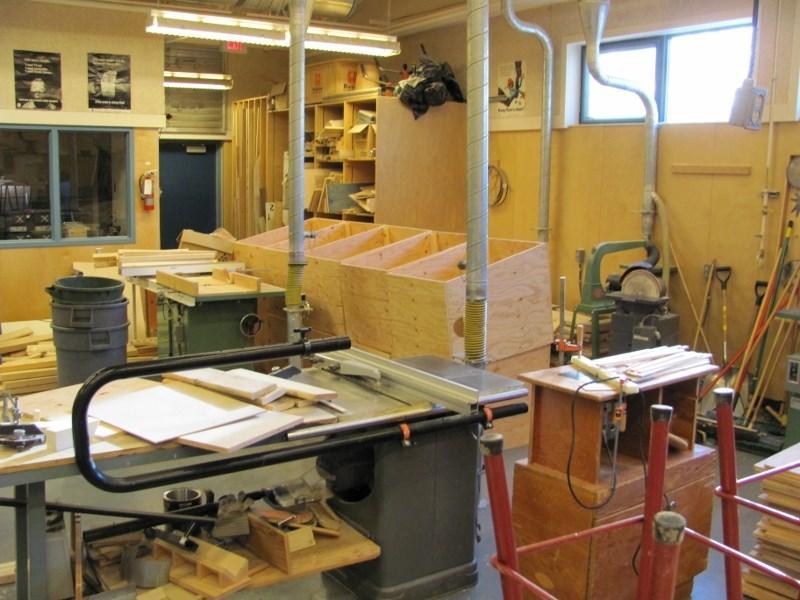Woodwork

WOODWORK 8
This is a six week course that introduces students to basic woodworking skills. Safe work habits will be stressed and maintained at all times. We will be working on several small projects with the main focus being on hand tools. Students will be exposed to all stages of project building from layout, shaping, sanding and finishing. Students in the grade 8 rotation will learn the skills to draw and match three dimensional drawings to two dimensional ones.
WOODWORK 9 (elective)
The Woodwork 9 course focuses on:
- student safety throughout the course as students learn to use both hand and power tools in a safe and proper manner.
- planning, drawing, constructing and finishing stages.
- how to interpret project plans and be able to select the proper resources.
- how their project's design is impacted by social, ethical, and sustainability considerations.
- students will be able to enhance their projects using either a CNC router or Laser engraving machine.
Students are required to provide their own safety goggles/eye protection, hearing protection and tape measure.
WOODWORK 10 (elective) 4 credits
The Woodwork 10 course focuses on:
- student safety throughout the course as students learn to use both hand a power tools in a safe and proper manner.
- planning, drawing, constructing and finishing stages.
- how to interpret project plans and be able to select the proper resources.
- how their projects design is impacted by social, ethical and sustainability considerations.
- students will be able to enhance their projects using either a CNC router or laser engraving machine.
Students who have successfully completed Woodwork 9 will be bale to work on more advanced projects than students taking this course for the first time.
Students are required to provide their own safety goggles/eye protection, hearing protection and tape measure.
WOODWORK 11 Prerequisite: Woodworking 10 preferred
In the Carpentry and Joinery 11 course, students are exposed to:
- the WHIMIS regulations and are trained to use the power equipment found in the woodshop.
- a large focus on safety and accident prevention during the first few weeks and these procedures are to be used throughout the course.
- interpreting technical drawings or producing design sketches.
- projects using both hand and machine tools that use a number of different wood joints.
- the WoodLINKS curriculum, which includes current industry trends as well as exposing them to a vast amount of information and resources on wood processing.
- the CNC router as a part of one of their projects.
- students will be able to enhance their projects using either a CNC router or Laser engraving machine.
WOODWORK 12 (elective) 4 credits
In the Carpentry and Joinery 12 course students:
- are exposed to the WHIMIS regulations and are trained to use all the power equipment found in the woodshop.
- are expected to apply safe work practices when completing personal projects as there is a large focus on safety and accident prevention during the first few weeks and it is reinforced throughout the course.
- begin by interpreting technical drawings, or producing design sketches, and demonstrate proficiency in using a variety of measuring instruments, layout tools, and mathematical techniques to solving technical problems.
- are then expected to complete projects that incorporate a number of different wood joints using both hand and machine tools.
- are also exposed to working with engineered wood products and composite materials.
- students are encouraged to utilize the CNC Router into part of one of their projects.
The WoodLINKS curriculum incorporates current industry trends as well as exposing students to vast amount on information and resources on wood processing and processing and production techniques.
DRAFTING 11 (elective) 4 credits
Topics and focus areas:
- Computer Assisted Aided Drawing (CAAD) is one of the fastest growing programs in education technology in B.C. CAD is used in a wide variety of occupations including dress designers, fire departments, the forest industry, construction, as well as traditional uses in shops.
- You will learn the method of drafting most professionals use now.
- Includes drawing such objects as machine parts, house plans, and furniture on computers.
- The fundamentals of 2-dimensional drafting through a series of 10 modules using AutoCAD.
- Your own area of study from topics such as 3-D drafting, 3-D modeling and animation, and CNC router operation.
